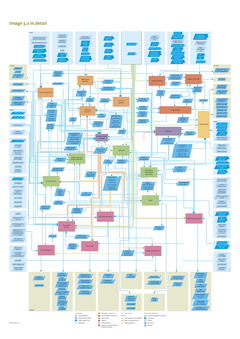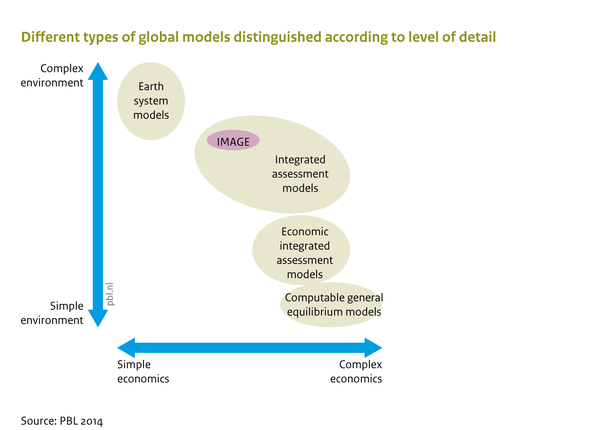IMAGE framework
| Projects/Applications |
| Models/Databases |
| Relevant overviews |
| References |
Setting the stage
Background
The IMAGE 3.3 framework addresses a set of global environmental issues and sustainability challenges. The most prominent are climate change, land-use change, biodiversity loss, modified nutrient cycles, and water scarcity. These highly complex issues are characterised by long-term dynamics and are either global issues, such as climate change, or manifest in a similar form in many places making them global in character. Typically, these global environmental issues have emerged as human societies have harnessed natural resources to support their development, such as providing energy, food, water and shelter.
Economic growth and increasing wealth have brought enormous benefits to human societies but have been accompanied by large-scale changes to the global environment system. These changes result from clearing land, burning biomass, domesticating animals and developing crop production systems, and human activities that have led to emissions of air pollutants and greenhouse gases. Humanity’s influence on the state and functioning of the natural environment has steadily increased in degree and spatial scale over the last 150 years.
Science now recognizes humans as a geological force (Zalasiewicz et al., 2010). Some suggestions have been made that the most recent age should be called the Anthropocene, a man-made era (although controversial). In the last decades, concern has been growing that the scale of human interaction with the natural environment reaches levels that could have consequences for the Earth’s capacity to continue supporting an increasing population or at least severe environmental degradation. For example, the emission of greenhouse gases is expected to lead to severe climate change.
Key policy challenges are how to reduce the current negative impact of human activity on natural systems and align development and sustainability ambitions. This requires understanding the present ‘state-of-the-world’ as a result of the main drivers in the past. It is also essential to explore how the world could unfold in the future and its implications, including how the degradation of natural systems influences opportunities for human development. Then, alternative pathways can be identified, and their merits and downsides assessed to guide policy-making.
To understand these complex, global and long-term issues and design effective response strategies, integrated assessment models such as IMAGE 3.3 have been developed. Integrated assessment models cover vital processes, ranging from human activities as the primary drivers to the behaviour of the natural system and impacts on the natural environment and human development.
Integrated environmental assessment
Integrated assessment models (IAMs) have been developed to describe the critical processes in the interaction of human development and the natural environment. IAM methods and tools draw on functional relationships between activities, such as the provision of food, water and energy, and the associated impacts. Traditionally, most IAMs focused on climate change and air pollution. More recently, these models have been expanded to assess an increasing number of impacts, such as air and water quality, water scarcity, depletion of non-renewable resources (fossil fuels, phosphorus), and overexploitation of renewable resources (fish stocks, forests). IAMs are designed to provide insight into how driving factors induce a range of impacts, considering some of the critical feedback and feed-forward mechanisms. To achieve this effectively, IAMs need to be sufficiently detailed to address the problem, yet simple enough to be applicable in assessments, including exploration of uncertainties, and without loss of transparency because of the complex relationships involved (see IMAGE framework part: Organisational set-up and scientific quality).
Objective and scope of IMAGE
IMAGE is a comprehensive, integrated modelling framework of interacting human and natural systems. Its design relies on intermediate complexity modelling, balancing the level of detail to capture critical processes and behaviour, and allowing for multiple runs to explore aspects of sensitivity and uncertainty of the complex, interlinked systems (see IMAGE framework part: A brief history of IMAGE).
The objectives of IMAGE are as follows:
- To analyze large-scale and long-term interactions between human development and the natural environment to gain better insight into the processes of global environmental change;
- To identify response strategies to global environmental change based on an assessment of options for mitigation and adaption;
- To indicate key interlinkages and associated levels of uncertainty in processes of global environmental change.
IMAGE is often used to explore two types of issues:
- How the future unfolds if no deliberate, drastic changes in prevailing economic, technology and policy developments are assumed, commonly referred to as baseline, business-as-usual, or no-new-policy assessment;
- How policies and measures prevent unwanted impacts on the global environment and human development.
Baseline Scenario
The baseline scenario is used to assess the magnitude and relevance of global environmental issues and how they relate to human activities (see publication The 2021 SSP scenarios of the IMAGE 3.2 model). This is important at the beginning of a policy cycle when an environmental issue arises. The scenario can be used to explore how the future might unfold under business-as-usual, to assess the costs and foregone opportunities of policy inaction, and to study the impacts on the natural environment of a human development pathway with essentially unaltered practices. To some degree, impacts are accounted for by endogenous feedbacks included in the model. For instance, changes in temperature and precipitation resulting from climate change affect agricultural productivity and water availability, the availability of renewable energy and heating/cooling demand. Feedbacks of this type are part of the IMAGE model; see framework components.
Alternative scenarios
Alternative scenarios often explore possible response strategies to a problem, such as a climate change, by assuming societal and policy responses to the impacts projected under baseline conditions. To this end, alternative cases are developed and implemented in model compatible terms to test how the outcomes change. They also reveal synergies and trade-offs between policy issues. For example, with increasing crop yields, less land is required to grow a given amount of crops, reducing biodiversity loss and leading to more carbon storage in ecosystems. Still, fertiliser application to increase yields may increase to sustain the higher yields with emissions to air, groundwater and surface water as a consequence. Furthermore, higher yields may contribute to lower food prices and thus to reducing undernourishment and hunger to the benefit of human health.
IMAGE in comparison to other IAMs
Various types of IAMs have been developed, evolving from different models with a specific disciplinary focus and point of entry. These are discussed briefly in order to identify the position of IMAGE in relation to other IAM models. The common feature of all IAM models is that they all describe a combination of the Human and Earth systems to understand global environmental problems better.
IMAGE is part of the IAMC, the Integrated Assessment Model Consortium. The IAMC models website offers an overview of several IAMs and their model properties. See the Reference card] page and the Model comparison page.
Detail versus simplification
As indicated above, a fundamental trade-off in integrated assessment modelling is adding detail versus simplification. Sufficient detail is required to include all relevant processes in both the Human and the Earth systems according to state-of-the-art knowledge. Simplicity is needed to ensure sufficient transparency in complex model systems and to explore uncertainties. For instance, a crop growth model with data input on observed, local climate, soil layers and crop variety parameters may perform well at field scale. However, such a model is less suitable for use in an IAM that requires more generic crop growth representation operating as part of a global scale system.
Another limitation to the level of detail captured in IAMs is the lack of consistent and complete datasets with global coverage. While models are developed for different purposes and thus have limited overlap in scope and detail, many hybrid models are in use. As illustrated in the figure below, IAM models are between models with a primary focus on the Earth system (Earth System Models) and models that focus on the Human system, such as pure economic models.
Different model groups exist within the IAM discipline, and IMAGE is characterized by relatively detailed biophysical processes and a wide range of environmental indicators. IMAGE 3.0 also includes an economic model to represent the agricultural system and a process model to describe the energy system but has less detail on economics and policy instruments than other energy models. In terms of application, many models are designed and used for climate policy analysis, such as FUND and DICE, while other models address a broader range of issues. IMAGE was initially designed to assess the global effect of greenhouse gas emissions and now covers a broad range of environmental and sustainability issues.
Model history
Another reason for differences between IAM models is their history. Many have evolved from technical process models of energy systems to cover environmental issues, such as air pollution and, more frequently also climatic change. Technical process models describe the physical energy flows from primary resources through conversion processes and transport and distribution networks to meet specific demands for energy carriers or energy services. The costs associated with the various components are tracked, and relative costs of competing technologies and supply chains determine market share. One example embedded in the IMAGE framework is the TIMER energy model (Component Energy supply and demand).
Other IAMs have their roots in economics and have evolved from models assessing the production of economic outputs to contribute to consumer utility by allocating input factors, such as capital, labour, and, increasingly, energy, materials, and natural resources. Substitution between sectors, inputs and commodities produced depends on their relative prices, taking into account policy interventions, such as taxes and subsidies, import regulations and other market and non-market instruments. Economic models include the OECD model ENV-Linkages and the model MAGNET model. The latter has been integrated into IMAGE 3.0 (see Component Agricultural economy).
While economic models account for consistency between economic sectors, these models tend to treat the economy in terms of material flows, biochemical, physical and ecological processes in a stylized way, limiting their capacity to capture feedback mechanisms of the natural system.
Geographic detail
Finally, IAMs can also be distinguished by the level of geographic detail in land-based activities. To address the geographical distribution of bio-geochemical and bio-geophysical processes in conjunction with human development, the IMAGE framework has been developed with a high level of geographic detail. IMAGE provides a relatively high level of detail on land-based processes, such as water, carbon and nutrient cycles, and derived indicators for biodiversity loss and flood risks, also in temporal and spatial resolution.

